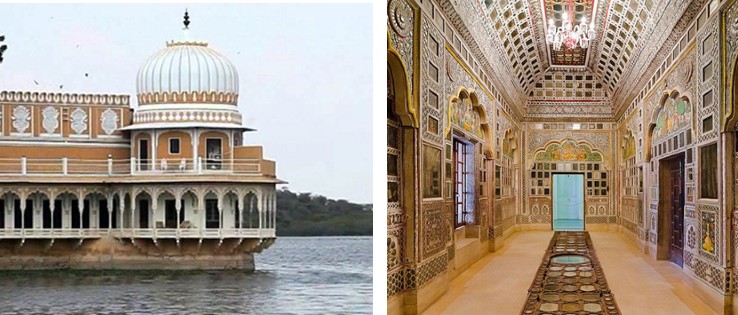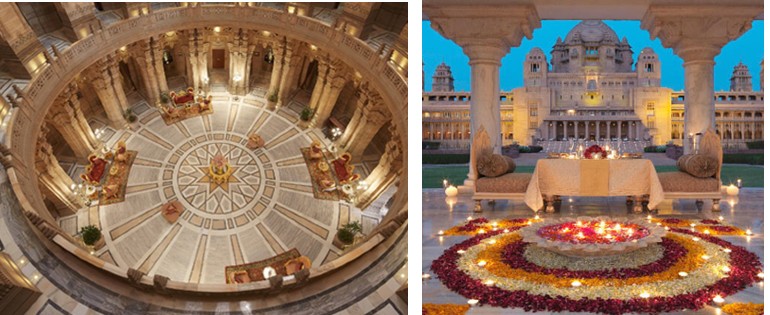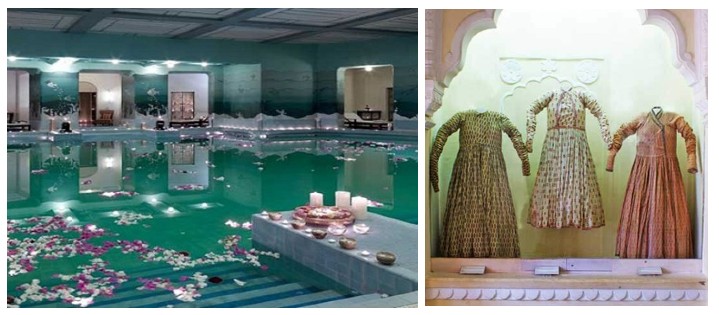
WoT's Hot
JODHPUR
The mighty Jodhpur.
The seat of power of the mightlyMarwar
The Sun city
The blue city.
This beautiful city.
Jodhpur!
Built by Rao Jodha in 1459 who shifted the capital from Mandore, Jodhpur wears a charismatic character, old world and classic.
It is said that at the time of partition, the ruler of Jodhpur, Hanwant Singh, did not want to join India, but finally did so due to the effective persuasion of SardarVallabhbhai Patel. So rich was Marwar that the king was being pursued by Jinnah and was promised that Marwar could even retain their own currency in Pakistan.
Both Mehrangarh Fort and Umaid Bhavan are grand structures that bear testimony to the scale and valor of the custodians of this old city.
Though the fortress was originally started in 1459 by Rao Jodha, most of the fort which stands today dates from the period of Jaswant Singh.
 Photo credits: Inside 1: Phool Mahal - jaipurtourism.in; Inside 1A: Sheesh Mahal - travelogyindia.com
Within the fort are several brilliantly crafted and decorated palaces. These include, Moti Mahal (Pearl Palace), Phool Mahal (Flower Palace), Sheesha Mahal (Mirror Palace), SilehKhana and DaulatKhana. The museum houses a collection of palanquins, howdahs, royal cradles, miniatures, musical instruments, costumes and furniture. The ramparts of the fort house preserved old cannon (including the famous Kilkila), and provided a breath-taking view of the city.
Photo credits: Inside 1: Phool Mahal - jaipurtourism.in; Inside 1A: Sheesh Mahal - travelogyindia.com
Within the fort are several brilliantly crafted and decorated palaces. These include, Moti Mahal (Pearl Palace), Phool Mahal (Flower Palace), Sheesha Mahal (Mirror Palace), SilehKhana and DaulatKhana. The museum houses a collection of palanquins, howdahs, royal cradles, miniatures, musical instruments, costumes and furniture. The ramparts of the fort house preserved old cannon (including the famous Kilkila), and provided a breath-taking view of the city.
 Photo credits:Inside 2: Umaid Bhavan Lounge-tajhotels.com; Inside 2A: Umaid Bhavan - traveltriangle.com
Much later in 1929 Maharaja Umaid Sigh built UmaidBhavanThe Palace was built to provide employment to thousands of people during the time of famine
Photo credits:Inside 2: Umaid Bhavan Lounge-tajhotels.com; Inside 2A: Umaid Bhavan - traveltriangle.com
Much later in 1929 Maharaja Umaid Sigh built UmaidBhavanThe Palace was built to provide employment to thousands of people during the time of famine
 Photo credits:Inside 3: Taj Palace - hauteliving.com; Inside 3A: Mehrangarh Museum - mehrangarh.com
The site chosen for the palace was on a hill known as Chittar hill in the outer limits of Jodhpur, after which the palace is also known. The palace is magnificent in its structure and is divided into three parts the residence of the royal family, a luxury Taj Palace Hotel, and a Museum focusing on the 20th century history of the Jodhpur Royal Family.
The architectural beauty of Umaid Bhavan Palace stands out. Made of sandstone, the central dome reminded me of the grand European monuments, so did the frescos inside made by JS Norblin.
It is said that so lavish is the palace that even the linings on the floor was made of silver.
Amidst this wonderful display of lineage and legacy my thoughts ambled to the present day custodians of the House of Marwar.
The son of the house is married with children.
The daughter who is elder to the son is not.
She is involved with restoration of the forts and museums as is her father and brother.
So what happens next, I thought?
Who inherits the legacy?
The elder child irrespective of gender or the male child by the accident of his gender?
Truly both the male and the female progenies are the custodians of the legacy.
Truly they should both be the legatees.
Even without dividing one single monument into two, there is surely enough to own and take charge of for both the daughter and the son.
Too many of the daughters of these prime family get left out of their legacies.
Something which is as much their birthright as their brothers.
In the name of protecting heritage often the daughters are denied totally.
In a country which recognises them equal by law.
Even after 60 years of independence.
Married or Unmarried the daughters of these houses need to acknowledged.
Food for thought?
Anyone?
To read more of Ipsita Ganguli's writings please log into www.ipsitaganguli.com
Photo credits:Inside 3: Taj Palace - hauteliving.com; Inside 3A: Mehrangarh Museum - mehrangarh.com
The site chosen for the palace was on a hill known as Chittar hill in the outer limits of Jodhpur, after which the palace is also known. The palace is magnificent in its structure and is divided into three parts the residence of the royal family, a luxury Taj Palace Hotel, and a Museum focusing on the 20th century history of the Jodhpur Royal Family.
The architectural beauty of Umaid Bhavan Palace stands out. Made of sandstone, the central dome reminded me of the grand European monuments, so did the frescos inside made by JS Norblin.
It is said that so lavish is the palace that even the linings on the floor was made of silver.
Amidst this wonderful display of lineage and legacy my thoughts ambled to the present day custodians of the House of Marwar.
The son of the house is married with children.
The daughter who is elder to the son is not.
She is involved with restoration of the forts and museums as is her father and brother.
So what happens next, I thought?
Who inherits the legacy?
The elder child irrespective of gender or the male child by the accident of his gender?
Truly both the male and the female progenies are the custodians of the legacy.
Truly they should both be the legatees.
Even without dividing one single monument into two, there is surely enough to own and take charge of for both the daughter and the son.
Too many of the daughters of these prime family get left out of their legacies.
Something which is as much their birthright as their brothers.
In the name of protecting heritage often the daughters are denied totally.
In a country which recognises them equal by law.
Even after 60 years of independence.
Married or Unmarried the daughters of these houses need to acknowledged.
Food for thought?
Anyone?
To read more of Ipsita Ganguli's writings please log into www.ipsitaganguli.com
 Photo credits: Inside 1: Phool Mahal - jaipurtourism.in; Inside 1A: Sheesh Mahal - travelogyindia.com
Within the fort are several brilliantly crafted and decorated palaces. These include, Moti Mahal (Pearl Palace), Phool Mahal (Flower Palace), Sheesha Mahal (Mirror Palace), SilehKhana and DaulatKhana. The museum houses a collection of palanquins, howdahs, royal cradles, miniatures, musical instruments, costumes and furniture. The ramparts of the fort house preserved old cannon (including the famous Kilkila), and provided a breath-taking view of the city.
Photo credits: Inside 1: Phool Mahal - jaipurtourism.in; Inside 1A: Sheesh Mahal - travelogyindia.com
Within the fort are several brilliantly crafted and decorated palaces. These include, Moti Mahal (Pearl Palace), Phool Mahal (Flower Palace), Sheesha Mahal (Mirror Palace), SilehKhana and DaulatKhana. The museum houses a collection of palanquins, howdahs, royal cradles, miniatures, musical instruments, costumes and furniture. The ramparts of the fort house preserved old cannon (including the famous Kilkila), and provided a breath-taking view of the city.
 Photo credits:Inside 2: Umaid Bhavan Lounge-tajhotels.com; Inside 2A: Umaid Bhavan - traveltriangle.com
Much later in 1929 Maharaja Umaid Sigh built UmaidBhavanThe Palace was built to provide employment to thousands of people during the time of famine
Photo credits:Inside 2: Umaid Bhavan Lounge-tajhotels.com; Inside 2A: Umaid Bhavan - traveltriangle.com
Much later in 1929 Maharaja Umaid Sigh built UmaidBhavanThe Palace was built to provide employment to thousands of people during the time of famine
 Photo credits:Inside 3: Taj Palace - hauteliving.com; Inside 3A: Mehrangarh Museum - mehrangarh.com
The site chosen for the palace was on a hill known as Chittar hill in the outer limits of Jodhpur, after which the palace is also known. The palace is magnificent in its structure and is divided into three parts the residence of the royal family, a luxury Taj Palace Hotel, and a Museum focusing on the 20th century history of the Jodhpur Royal Family.
The architectural beauty of Umaid Bhavan Palace stands out. Made of sandstone, the central dome reminded me of the grand European monuments, so did the frescos inside made by JS Norblin.
It is said that so lavish is the palace that even the linings on the floor was made of silver.
Amidst this wonderful display of lineage and legacy my thoughts ambled to the present day custodians of the House of Marwar.
The son of the house is married with children.
The daughter who is elder to the son is not.
She is involved with restoration of the forts and museums as is her father and brother.
So what happens next, I thought?
Who inherits the legacy?
The elder child irrespective of gender or the male child by the accident of his gender?
Truly both the male and the female progenies are the custodians of the legacy.
Truly they should both be the legatees.
Even without dividing one single monument into two, there is surely enough to own and take charge of for both the daughter and the son.
Too many of the daughters of these prime family get left out of their legacies.
Something which is as much their birthright as their brothers.
In the name of protecting heritage often the daughters are denied totally.
In a country which recognises them equal by law.
Even after 60 years of independence.
Married or Unmarried the daughters of these houses need to acknowledged.
Food for thought?
Anyone?
To read more of Ipsita Ganguli's writings please log into www.ipsitaganguli.com
Photo credits:Inside 3: Taj Palace - hauteliving.com; Inside 3A: Mehrangarh Museum - mehrangarh.com
The site chosen for the palace was on a hill known as Chittar hill in the outer limits of Jodhpur, after which the palace is also known. The palace is magnificent in its structure and is divided into three parts the residence of the royal family, a luxury Taj Palace Hotel, and a Museum focusing on the 20th century history of the Jodhpur Royal Family.
The architectural beauty of Umaid Bhavan Palace stands out. Made of sandstone, the central dome reminded me of the grand European monuments, so did the frescos inside made by JS Norblin.
It is said that so lavish is the palace that even the linings on the floor was made of silver.
Amidst this wonderful display of lineage and legacy my thoughts ambled to the present day custodians of the House of Marwar.
The son of the house is married with children.
The daughter who is elder to the son is not.
She is involved with restoration of the forts and museums as is her father and brother.
So what happens next, I thought?
Who inherits the legacy?
The elder child irrespective of gender or the male child by the accident of his gender?
Truly both the male and the female progenies are the custodians of the legacy.
Truly they should both be the legatees.
Even without dividing one single monument into two, there is surely enough to own and take charge of for both the daughter and the son.
Too many of the daughters of these prime family get left out of their legacies.
Something which is as much their birthright as their brothers.
In the name of protecting heritage often the daughters are denied totally.
In a country which recognises them equal by law.
Even after 60 years of independence.
Married or Unmarried the daughters of these houses need to acknowledged.
Food for thought?
Anyone?
To read more of Ipsita Ganguli's writings please log into www.ipsitaganguli.com
JODHPUR
The mighty Jodhpur.
The seat of power of the mightlyMarwar
The Sun city
The blue city.
This beautiful city.
Jodhpur!
Built by Rao Jodha in 1459 who shifted the capital from Mandore, Jodhpur wears a charismatic character, old world and classic.
It is
Other Articles in Wots Hot
What to read next
Featured articles

Welcome Festive Season in Glam, Latin Quarters Launches new #PujoBling Collection with Monami Ghosh
by WOT








































